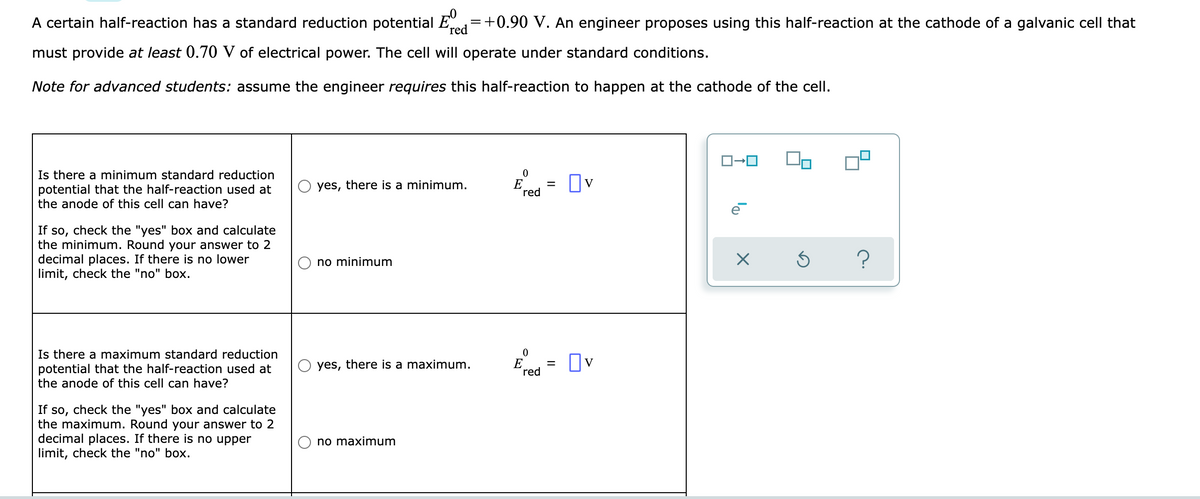A certain half-reaction has a standard reduction potential Ered=+0.90 V. An engineer proposes using this half-reaction at the cathode of a galvanic cell that must provide at least 0.70 V of electrical power. The cell will operate under standard conditions. Note for advanced students: assume the engineer requires this half-reaction to happen at the cathode of the cell. Is there a minimum standard reduction potential that the half-reaction used at the anode of this cell can have? O yes, there is a minimum. 0 red v If so, check the "yes" box and calculate the minimum. Round your answer to 2 decimal places. If there is no lower limit, check the "no" box. O no minimum Is there a maximum standard reduction potential that the half-reaction used at the anode of this cell can have? O yes, there a maximum. = Ov If so, check the "yes" box and calculate the maximum. Round your answer to 2 decimal places. If there is no upper limit, check the "no" box. Ono maximum red ローロ e 2.
A certain half-reaction has a standard reduction potential Ered=+0.90 V. An engineer proposes using this half-reaction at the cathode of a galvanic cell that must provide at least 0.70 V of electrical power. The cell will operate under standard conditions. Note for advanced students: assume the engineer requires this half-reaction to happen at the cathode of the cell. Is there a minimum standard reduction potential that the half-reaction used at the anode of this cell can have? O yes, there is a minimum. 0 red v If so, check the "yes" box and calculate the minimum. Round your answer to 2 decimal places. If there is no lower limit, check the "no" box. O no minimum Is there a maximum standard reduction potential that the half-reaction used at the anode of this cell can have? O yes, there a maximum. = Ov If so, check the "yes" box and calculate the maximum. Round your answer to 2 decimal places. If there is no upper limit, check the "no" box. Ono maximum red ローロ e 2.
Principles of Modern Chemistry
8th Edition
ISBN:9781305079113
Author:David W. Oxtoby, H. Pat Gillis, Laurie J. Butler
Publisher:David W. Oxtoby, H. Pat Gillis, Laurie J. Butler
Chapter17: Electrochemistry
Section: Chapter Questions
Problem 83AP
Related questions
Question

Transcribed Image Text:A certain half-reaction has a standard reduction potential
-0
red
=
= +0.90 V. An engineer proposes using this half-reaction at the cathode of a galvanic cell that
must provide at least 0.70 V of electrical power. The cell will operate under standard conditions.
Note for advanced students: assume the engineer requires this half-reaction to happen at the cathode of the cell.
ロ→ロ
0
Is there a minimum standard reduction
potential that the half-reaction used at
the anode of this cell can have?
yes, there is a minimum.
☐v
red
If so, check the "yes" box and calculate
the minimum. Round your answer to 2
decimal places. If there is no lower
limit, check the "no" box.
no minimum
Ś ?
0
Is there a maximum standard reduction
potential that the half-reaction used at
the anode of this cell can have?
yes, there is a maximum.
Ov
red
If so, check the "yes" box and calculate
the maximum. Round your answer to 2
decimal places. If there is no upper
limit, check the "no" box.
no maximum
E
E
=
=
X
Expert Solution
This question has been solved!
Explore an expertly crafted, step-by-step solution for a thorough understanding of key concepts.
This is a popular solution!
Trending now
This is a popular solution!
Step by step
Solved in 2 steps

Knowledge Booster
Learn more about
Need a deep-dive on the concept behind this application? Look no further. Learn more about this topic, chemistry and related others by exploring similar questions and additional content below.Recommended textbooks for you

Principles of Modern Chemistry
Chemistry
ISBN:
9781305079113
Author:
David W. Oxtoby, H. Pat Gillis, Laurie J. Butler
Publisher:
Cengage Learning

Chemistry: An Atoms First Approach
Chemistry
ISBN:
9781305079243
Author:
Steven S. Zumdahl, Susan A. Zumdahl
Publisher:
Cengage Learning


Principles of Modern Chemistry
Chemistry
ISBN:
9781305079113
Author:
David W. Oxtoby, H. Pat Gillis, Laurie J. Butler
Publisher:
Cengage Learning

Chemistry: An Atoms First Approach
Chemistry
ISBN:
9781305079243
Author:
Steven S. Zumdahl, Susan A. Zumdahl
Publisher:
Cengage Learning


Chemistry
Chemistry
ISBN:
9781305957404
Author:
Steven S. Zumdahl, Susan A. Zumdahl, Donald J. DeCoste
Publisher:
Cengage Learning

Chemistry: Principles and Practice
Chemistry
ISBN:
9780534420123
Author:
Daniel L. Reger, Scott R. Goode, David W. Ball, Edward Mercer
Publisher:
Cengage Learning

Chemistry: The Molecular Science
Chemistry
ISBN:
9781285199047
Author:
John W. Moore, Conrad L. Stanitski
Publisher:
Cengage Learning